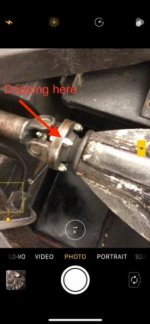Chet Zerlin
Jedi Trainee
Offline
Sometimes I think I'm playing a game of whac-a-mole chasing oil leaks on my Healey (well at least I've got something to do with my spare time!).
Here's a picture of where the latest one seems to be coming from (hopefully you can see the arrow). It's dripping down the seam between the two flanges.
All bolts are tight...is there an oil seal or gasket inside?
Thanks!
Chet
Here's a picture of where the latest one seems to be coming from (hopefully you can see the arrow). It's dripping down the seam between the two flanges.
All bolts are tight...is there an oil seal or gasket inside?
Thanks!
Chet

 Hi Guest!
Hi Guest!

 smilie in place of the real @
smilie in place of the real @
 Pretty Please - add it to our Events forum(s) and add to the calendar! >>
Pretty Please - add it to our Events forum(s) and add to the calendar! >> 





